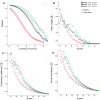Development of large-scale functional brain networks in children
- PMID: 19621066
- PMCID: PMC2705656
- DOI: 10.1371/journal.pbio.1000157
Development of large-scale functional brain networks in children
Abstract
The ontogeny of large-scale functional organization of the human brain is not well understood. Here we use network analysis of intrinsic functional connectivity to characterize the organization of brain networks in 23 children (ages 7-9 y) and 22 young-adults (ages 19-22 y). Comparison of network properties, including path-length, clustering-coefficient, hierarchy, and regional connectivity, revealed that although children and young-adults' brains have similar "small-world" organization at the global level, they differ significantly in hierarchical organization and interregional connectivity. We found that subcortical areas were more strongly connected with primary sensory, association, and paralimbic areas in children, whereas young-adults showed stronger cortico-cortical connectivity between paralimbic, limbic, and association areas. Further, combined analysis of functional connectivity with wiring distance measures derived from white-matter fiber tracking revealed that the development of large-scale brain networks is characterized by weakening of short-range functional connectivity and strengthening of long-range functional connectivity. Importantly, our findings show that the dynamic process of over-connectivity followed by pruning, which rewires connectivity at the neuronal level, also operates at the systems level, helping to reconfigure and rebalance subcortical and paralimbic connectivity in the developing brain. Our study demonstrates the usefulness of network analysis of brain connectivity to elucidate key principles underlying functional brain maturation, paving the way for novel studies of disrupted brain connectivity in neurodevelopmental disorders such as autism.
Conflict of interest statement
The authors have declared that no competing interests exist.
Figures





Comment in
-
From child to young adult, the brain changes its connections.PLoS Biol. 2009 Jul 21;7(7):e1000158. doi: 10.1371/journal.pbio.1000158. PLoS Biol. 2009. PMID: 20076749 Free PMC article. No abstract available.
References
-
- Giedd J. N, Blumenthal J, Jeffries N. O, Castellanos F. X, Liu H, et al. Brain development during childhood and adolescence: a longitudinal MRI study. Nat Neurosci. 1999;2:861–863. - PubMed
-
- Good C. D, Johnsrude I. S, Ashburner J, Henson R. N, Friston K. J, et al. A voxel-based morphometric study of ageing in 465 normal adult human brains. NeuroImage. 2001;14:21–36. - PubMed
-
- Thompson P. M, Giedd J. N, Woods R. P, MacDonald D, Evans A. C, et al. Growth patterns in the developing brain detected by using continuum mechanical tensor maps. Nature. 2000;404:190–193. - PubMed
-
- Pujol J, Vendrell P, Junque C, Marti-Vilalta J. L, Capdevila A. When does human brain development end? Evidence of corpus callosum growth up to adulthood. Ann Neurol. 1993;34:71–75. - PubMed
Publication types
MeSH terms
Grants and funding
LinkOut - more resources
Full Text Sources

